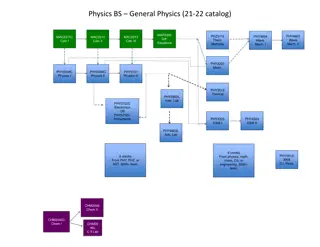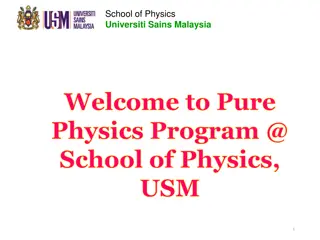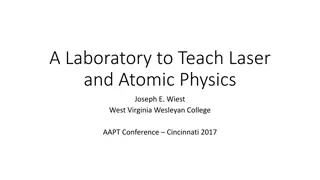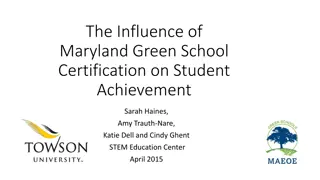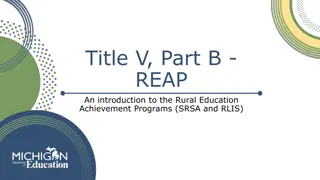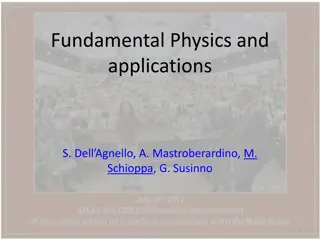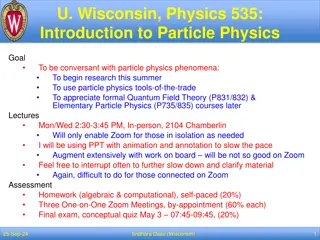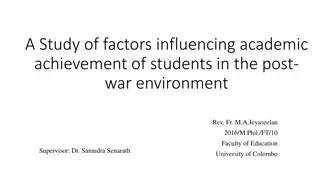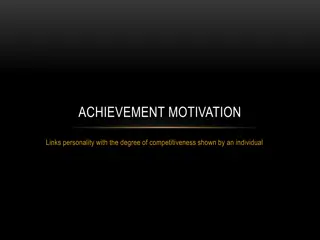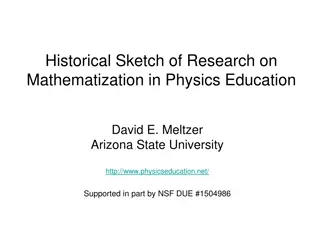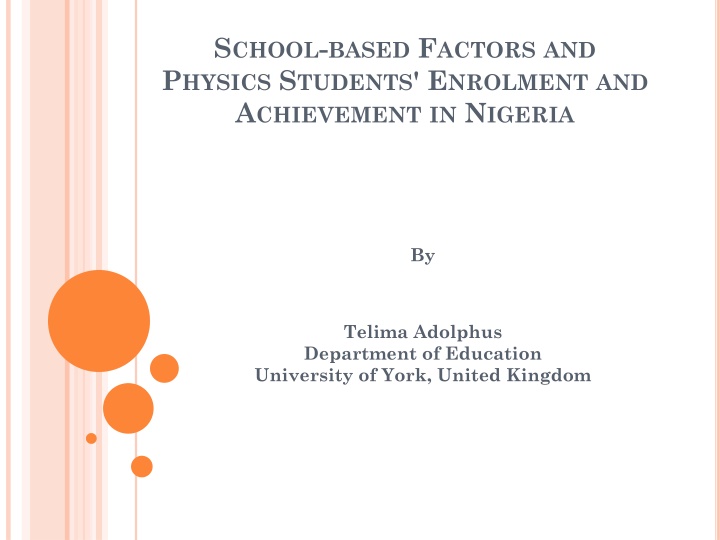
Factors Influencing Physics Students' Enrollment and Achievement in Nigeria
Explore the impact of school-based factors on physics students' success in Nigeria. Data from Senior School Certificate Examinations reveals trends in enrollment and achievement, highlighting challenges and opportunities for improvement. Research methods employed questionnaires, interviews, observations, and tests to gather insights from students and teachers.
Download Presentation

Please find below an Image/Link to download the presentation.
The content on the website is provided AS IS for your information and personal use only. It may not be sold, licensed, or shared on other websites without obtaining consent from the author. If you encounter any issues during the download, it is possible that the publisher has removed the file from their server.
You are allowed to download the files provided on this website for personal or commercial use, subject to the condition that they are used lawfully. All files are the property of their respective owners.
The content on the website is provided AS IS for your information and personal use only. It may not be sold, licensed, or shared on other websites without obtaining consent from the author.
E N D
Presentation Transcript
SCHOOL-BASED FACTORS AND PHYSICS STUDENTS' ENROLMENT AND ACHIEVEMENT IN NIGERIA By Telima Adolphus Department of Education University of York, United Kingdom
THE PROBLEM Despite the place of physics in science, technology and national development, its teaching and learning characterized with challenges which prevent many students from performing well in external examinations (FGN 2009:ii). has been
THE PROBLEM (DATA) Students SSCE Science Enrolment/Achievement in Nigeria Year Total SSCE Biology Chemistry Physics % % Credit Pass % % Credit Pass % % Credit Pass Enrolment Enrolment Enrolment Enrolment 2004 1051246 99.4 28.7 32.4 36.5 31.8 47.8 2005 1091763 99.4 35.0 33.1 49.8 32.6 40.8 2006 1184223 99.3 48.3 33.3 44.0 18.7 56.9 2007 1275330 99.4 32.8 34.1 45.1 33.3 42.9 2008 1369142 99.4 33.3 34.2 43.3 33.9 47.1 2009 1373009 99.3 27.7 34.8 42.5 34.6 46.2 2010 1351557 99.3 48.5 35.8 49.5 35.6 50.2 2011 1540250 99.4 37.5 37.3 48.0 37.1 62.6 2012 1695878 99.4 34.7 37.8 42.2 37.6 67.2 2013 1689188 99.4 50.8 38.5 71.2 38.3 46.0 Source: West African Examinations Council, Lagos, Nigeria
RESEARCH QUESTION One principal research question was formulated to guide the study: What school-based factors influence physics students enrolment and achievement in the Senior School Certificate Examinations? Workineh (2002) reported the result of a study conducted in 22 developing countries and reported to The World Bank that school based factors were highly recognized as influencing factors in determining achievement in developing countries while socio- economic factors were stated as influencing factors in determining achievement in developed countries. students academic students academic
RESEARCH METHODS/SAMPLING Mixed methods were utilized. Particularly, the researcher used: Questionnaires Interviews Observations and Tests Sample size 248 physics students 116 non-physics students and 14 physics teachers
RESULTS Teachers response on the availability of teaching resources in core topic areas in physics 80 70 60 50 % of Responses 40 Don't Have Don't Have Enough Have Enough 30 20 10 0 interaction of matter space and time conservation principles fields at rest and in motion energy wave motion without material transfer quantization and duality of matter Core Topic Areas
RESULTSCONTD Pearson Correlation of Students Achievement with Teacher and Resource Factors Resource Availability index Resource Utilizatio n index PAT scores Teacher Qualification Teaching Experience PAT scores Pearson Correlation 1 .587** .096 .591** .324** Sig. (2- tailed) .000 .213 .000 .000 171 171 171 171 171 N
RESULTSCONTD Pearson Correlation of Students Enrolment with Teacher and Resource Factors % of students in SS3 enrolled for physics Number of years of teaching experience Resource availability index Resource utilization index Teacher Qualification % of students in SS3 enrolled for physics Pearson Correlation 1 .562 .122 .532 .215 Sig. (2- tailed) .147 .773 .175 .610 8 8 8 8 8 N
RESULTSFROMINTERVIEWDATA CONTD From our SS I classes, we did not have a physics teacher then we had a Corper he didn t know what he was doing, so that made so many students in SS I to enrol away from physics (A2PS/2, 241-245). (Note: A Corper is a fresh university graduate undergoing the mandatory National service in Nigeria) I choose to be a physics student because of the teachers we have in this school and due to the facilities (B1PS/2, 20-21).
SUMMARY/CONCLUSION/RECOMMENDATION Teacher Qualification Resource Availability Resource Utilization Teacher Qualification Resource Availability Enrolment Achievement Teaching Experience Resource Utilization Teaching Experience schools in the area are poorly financed, with lack of adequate teaching resources, Lack of teacher professional development, Unavailability of computers with internet access and Lack of adequately qualified physics teachers. recommended that government and stake holders in the education industry do something urgent to recruit qualified physics teachers, train and retrain teachers in service and provide laboratories and other teaching and learning.
REFERENCES Adeyemi, T. O. (2008). Science laboratories and the quality of output from secondary schools in Ondo State, Nigeria. Asian Journal of Information Management, 2,23-30 . Bello, T. O. (2011). Effect of Group Instructional Strategy on Students Performance in Selected Physics Concepts. The African Symposium. 11(1), 71-79. Angell, C., Guttersrud, O., Henriksen, E.K. & Isnes, A. (2004). Physics: Frightful, But Fun Pupils and Teachers Views of Physics and Physics Teaching. Science education, 88(5), 683-706. Cohen, L., Manion, L., & Morrison, K. (2011). Research Methods in Education:7th Edition. London: Routledge. Creswell, J.W (2012). Educational Research: Planning, Conducting, and Evaluating Quantitative and Qualitative Research. 4th Boston: Pearson Education, Inc. Federal Ministry of Education (2009). National physics curriculum for senior secondary schools: Abuja: Nigerian Educational Research and Development Council. Heyneman, S. & Loxley, W. (1983). The effect of primary school quality on academic achievement across twenty-nine high- and low-income countries. American Journal of Sociology, 88, 1162 -1194. Jaiyeoba, A.O. & Atanda, A.I. (2011). School quality factors and secondary school students achievement in mathematics in south-western and north-central Nigeria. The African Symposium, 11(1), 91-100. Nwankwo, O.C. (2010). Practical Guide to Research Writing. Port Harcourt, Golden publishers Limited. Workineh, G. (2002). School based factors contributing to differences in students' achievement at high and low passing rate scorers of Government Secondary Schools of Addis Ababa at National Examination. Unpublished M.A. thesis, Addis Ababa University, Ethiopia. Rumsey, D.J. (2011). Statistics For Dummies, 2nd Edition, New Jersey: John Wiley & Sons.




